I ordered 3kg of Vanessa Kimbell’s Botanical Blend No.2 Meadow Blend and was very curious to bake with it. The flour looks and smells amazing. At the same time, I dug up an old raisin bread recipe from the original Tartine Bread book (2010) thinking that this week I’d bake some sourdough raisin bread for the customers at COGS.
Here’s what happened.
For the botanical loaf I made a 1.4kg loaf which is double the size of the loaves I sell each week. I had an old proofing basket (banneton) that I wanted to use and thought, “Why not?”
I followed Kimbell’s guide for flour ratios: 80% strong white flour and 20% botanical blend No.2. I had a guess at 76% hydration, figuring that the botanical flour could easily take more water but that I didn’t want to end up wrangling 1.4kg of wet dough into a banneton.
The raisin loaf is actually a variation on Tartine’s wholewheat loaf with the addition of soaked and drained raisins (at about 43% of the total flour in the recipe), and a bit of toasted ground coriander for some spicy warmth. I dropped the hydration down from the regular 80% (wholewheat flour absorbs more water than white flour) to 76%.
The doughs bulk fermented beautifully over about 5 1/2 hours (at around 26ºC) after initial mixing. Here are the two loaves after the first shaping.
 Both loaves after first shaping. The raisin loaf looks absurdly small.
Both loaves after first shaping. The raisin loaf looks absurdly small.
The raisin bread dough was way too stiff so I’ll return the hydration to 80% for when I bake it next.
The botanical loaf was beautifully proved and it’s quite possibly one of the nicest breads I’ve ever tasted. It is richly coloured, with a delicate crunch to the crust and the loaf I baked was huge.
 Both loaves after baking
Both loaves after baking
It’s not clear to me why the botanical loaf didn’t open out to give a pronounced ear but perhaps it was slightly overproved? (I doubt it given how much lift off the oven it got — which you can see in the crumbshot below).
 Note that curved shape at the bottom of the loaf – like it was trying to lift itself off the baking surface.
Note that curved shape at the bottom of the loaf – like it was trying to lift itself off the baking surface.
 Slightly tighter crumb due to lower hydration. Also I didn’t wait until it was properly cooled before slicing!
Slightly tighter crumb due to lower hydration. Also I didn’t wait until it was properly cooled before slicing!
I’m excited to share both these loaves with customers so this week (Saturday (9 December) I’ll bake a batch of Simple loaves and a batch of the raisin and coriander loaves. Next week I plan to make some regular size botanical loaves as a one-off for COGS customers — the flour is too expensive to buy it regularly. Stay tuned.